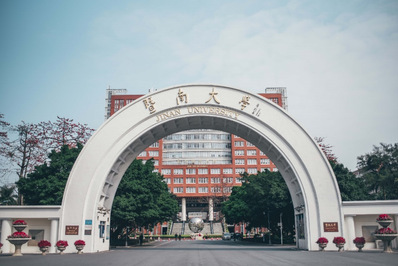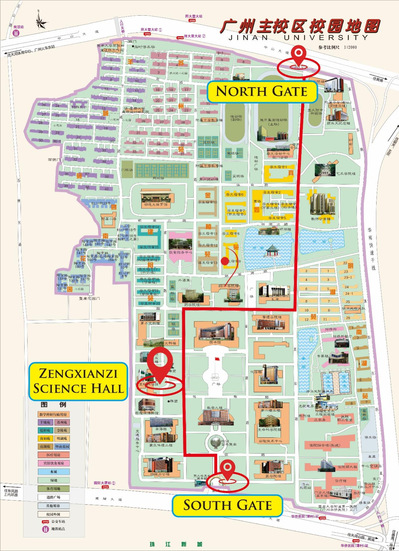About Guangzhou
Guangzhou is located in southern China in the middle of Guangdong province, north of the Pearl River Delta. The city also lies close to the South China Sea, Hong Kong, and Macau. Because of its convenient geographical position, Guangzhou has been called ‘China’s Southern Gateway’. As the capital of Guangdong province, Guangzhou is the center of its politics, economy, science, and education. It is also southern China's key transportation hub and trading port.
As the center of Chinese Lingnan Culture, Guangzhou is a famous cultural city with a history of more than 2,200 years. You can explore the ancient history at Nanyue King’s Museum, Chen Clan Ancestral Hall, Guangdong Museum, Guangxiao Temple, Baiyun Mountain, and Dr Sun Yat-sen Memorial Hall. Alternatively, you can witness China's spectacular transformation into modernity at the CantonTower and Zhujiang New Town.
Conference Venue
Jinan University (Shipai Campus)
Address: No.601 West Huangpu Avenue, Guangzhou City, Guangdong Province, China.

Hotel Recommendations
Vanburgh Hotel
(云来斯堡酒店)
Address: No.126 West Huangpu Avenue, Guangzhou City, Guangdong Province, China.

Hampton by Hilton Guangzhou Zhujiang New Town
(广州珠江新城希尔顿欢朋酒店)
Address: 495 Huang Pu Da Dao Xi Rd, Tianhe District, Guangzhou, 510627, China.

Yicheng Hotel (Guangzhou Zhujiang New Town Jida)
怡程酒店(广州珠江新城暨大店)
Address: Guofang Building, No. 503 West of Huangpu Avenue,Tianhe District,Guangzhou,Guangdong.

JNU Campus Map

How to Apply for a Chinese Visa
1. Find out if you need a visa. You will need to apply for a Chinese visa unless you meet one of China's visa-free policies. For more instructions, please refer to: https://www.visaforchina.cn/globle/.
Visa-Free Policy (September 15, 2025 Update)
Nationals of the following countries can, with ordinary passports, enter China visa-free for different purposes, provided that their stay periods will not exceed 30 days:
-Europe (33 countries): Andorra, Austria, Belgium, Bulgaria, Croatia, Cyprus, Denmark, Estonia, Finland, France, Germany, Greece, Hungary, Iceland, Ireland, Italy, Latvia, Liechtenstein, Luxembourg, Malta, Monaco, Montenegro, the Netherlands, North Macedonia, Norway, Poland, Portugal, Romania, Russia, Slovakia, Slovenia, Spain, Switzerland
-Oceania (2 countries): Australia, New Zealand
-Asia (7 countries): Bahrain, Brunei, Japan, Kuwait, Oman, Saudi Arabia, South Korea
-South America (5 countries): Argentina, Brazil, Chile, Peru, Uruguay
240h Visa-free Transit Policy
China currently offers a 240-hour visa-free transit policy for travelers from 55 countries. Please note that this policy applies only to passengers transiting through China to a third country/region (e.g., London–Guangzhou–Hong Kong).
For more details, please check the following website:
https://en.nia.gov.cn/n147418/n147463/c183412/content.html
2. Choose a visa type. Either a Tourist Visa (Type L) or a Visiting Visa (Type F) is qualified for your visit.
3. Prepare the required documents.
4. Submit the application. You may apply to the Visa Office at Chinese embassies, consulates, or China Visa Application Service Centers (CVASC) if they operate in your country.
5. Pay the fee and collect your visa. Go to the place where you apply for a China visa, pay the fee, and collect your visa. It is recommended that you apply for the visa two months before the intended travel.
How to Get to Guangzhou
By Air
Guangzhou Baiyun International Airport is one of the main transport hubs, providing excellent connections to major cities worldwide.
By Train
Guangzhou has two main train stations, Guangzhou South Railway Station and Guangzhou East Railway Station. The latter station takes only 20 minutes by car to the city center.
Inner-city Transportation
Metro
Guangzhou metro network covers much of the city. For the metro route map, please refer to: https://ydyc.gzmtr.cn:19090/indexBrowser.html#/index
The following metro stations in Line 3 may be helpful for the conference participants:
Gangding (near the west gate of Jinan University)
Tiyuxilu (a vital transfer station close to the commercial district)
Zhujiang New Town (CBD)
Airport South (Terminal 1)
Airport North (Terminal 2)

Taxi
Flag down a taxi
Guangzhou taxis are usually painted red, yellow, green, or blue. Please look for a taxi standing zone or try a side road when signaling a taxi. Very few taxi drivers speak English. Please show them the destination's Chinese name and ensure they turn on the meter.
Fares
The flag-down fare is RMB 12 for the first 3 kilometers (1.8 miles). Passengers pay the charge that is displayed on the taximeter at the destination.
Receipt
Most taxi drivers only accept small changes or online payments. After you pay the fare, please ask for the receipt and keep it. The receipt has the taxi's plate number on it. If you have any complaints or leave something in the taxi, you can call the taxi company's number to follow up.
E-hailing
Didi E-hailing service is recommended for transportation. You can download the English version of the application. An active Chinese mobile phone number is required for calling service. You can choose your route, car type, and price; payment will be automatically deducted after the trip. A foreign credit or debit card may not work for payment unless you link them to WeChat or Alipay.
Bus
The ticket fare for bus routes in urban areas is generally RMB 2 per ride. There are few English signboards at bus stops, and the buses will be broadcast in Chinese, Cantonese, and English. However, the multifarious bus lines and the hard-to-understand stop names could still be challenging if you cannot read Chinese.
Digital Payments in China
While some vendors still accept cash, it is becoming increasingly rare, especially in urban areas. Many stores, restaurants, and even transportation services prefer mobile payments through Alipay and WeChat Pay.
How to Link Your Credit Card to Alipay
1. Download the Alipay App: Start by downloading the Alipay app from your app store. It is available for both iOS and Android devices.
2. Create an Account: Open the app and follow the instructions to create an account. You will need to verify your identity, usually through your passport and phone number.
3. Add Your Credit Card: Once your account is set up, go to the “Me” section in the app, then select “Bank Cards.” Here, you can add your Visa or MasterCard by entering your card details. Alipay will verify the card, and once it is linked, you are ready to make payments.
4. Test the Payment: If possible, visit a local Chinese merchant in your area and try making a small payment using the Alipay app. This will help you familiarize yourself with the process and ensure everything is working correctly before your trip.
How to Link Your Credit Card to WeChat Pay
1. Download WeChat: If you do not already have WeChat, download it from your app store.
2. Set Up WeChat Pay: Open WeChat, go to the “Me” section, then select “WeChat Pay.” You might need to verify your identity, which is similar to Alipay.
3. Add Your Credit Card: In the WeChat Pay section, select “Cards” and then “Add Card.” Enter your Visa or MasterCard details. WeChat will verify the card, and once linked, you are ready to use it for payments.
4. Practice Payment: Just like with Alipay, try to make a small payment to ensure everything is functioning correctly.
Network and Wifi
All participants will be provided with wireless internet during the conference. Please note that you may need additional app tools if you need to use foreign apps, such as Google, Gmail, and YouTube, in mainland China.
Contacts
IESR Administrative Secretary
Siqi Liu (Suki): +86 13692794275


Xiangyan Qiu (Juno): +86 15820255811


Office Contact: +020 8522 313
Full document
![]() Logistical Information_2025 Jinan-SMU Conference on Urban and Regional Economics_251011 Update.pdf
Logistical Information_2025 Jinan-SMU Conference on Urban and Regional Economics_251011 Update.pdf


